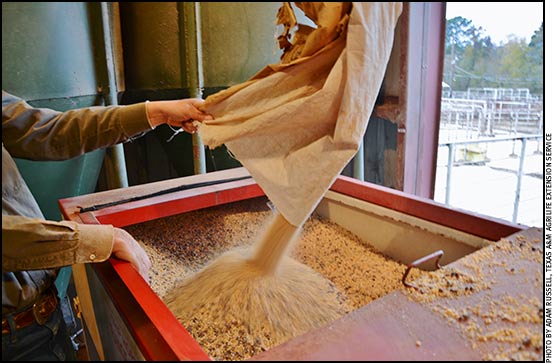
Low grain prices could mean lower feed prices for livestock producers through the winter.
Bumper Midwest Grain Crop
Low grain prices are bad for farmers but good for livestock producers.
Plentiful grain supplies likely mean low crop prices for farmers but also lower costs for livestock producers looking for feed options through winter, said a Texas A&M AgriLife Extension Service economist.
Mark Welch, AgriLife Extension grains marketing economist, College Station, said the expected drier weather pattern through winter could cause problems for cattle producers’ winter pastures and potential grazing, but abundant supplies of grains and subsequent low prices could mean lower feed costs for all livestock.
Corn prices should remain low and steady, he said, following heavy yields at harvest for U.S. and Texas producers.
“There was a whale of a corn crop this year,” he said. “Acreage was down, but with the varieties we have now and the techniques that farmers employ, those acres brought unprecedented yields.”
Sorghum, another important grain that creates feed, fuel and food for Texas and U.S. markets, also had a banner production year but is expected to garner low prices, he said. Corn and sorghum acres were lower in 2017 compared to the year before, but above-average yields contributed to high supply numbers and, therefore, lower price trends.
Those above-average yields for the two major grains will be good for livestock producers who will find lower feed prices on various nutritional sources that could supplement traditional forages, Welch said. However, grain producers will likely continue to see stagnant prices.
“It’s been a doldrum for corn prices the last few years,” he said. “We’re seeing $3.40 to $3.60 per bushel (bu.), and going into 2018, I don’t see that trend changing much from a producer’s price outlook.”
Grain from other producing nations could depress prices further, or be a catalyst for a rise in domestic prices, Welch said.
Corn prices reacted positively for farmers in June and July with the news of fewer planted corn acres nationally and dry conditions in the western portions of the Corn Belt and wet conditions in eastern portions of the Corn Belt, Welch said. Concerns were abated and the price jump was short-lived.
The same could happen if South American grain crops face problematic weather or some other misfortune during their growing season, which is now under way, Welch said.
“Our harvest gets us to February-March, but if there is anything that could derail the price trends, it would happen in South America,” he said. “Any problems and we might see firming prices, but if they bring in above-average yields like we did, you could see prices continuing at relatively depressed levels.”
Welch said oilseed production continues to expand as stressed producers view soybeans, sunflowers, canola and sesame as potential alternatives to feedgrain and wheat production.
Cattle producers should also see good prices on oilseeds as feed, including cottonseed and soybean meal.
Low feed prices could mean further expansion of already record production numbers in the livestock industry, Welch said. U.S. poultry and pork producers set production records last year, and cattle markets are still good for ranchers.
“Feed prices could support expansion of the industry that is at an all-time record high for production,” he said. “The cost component of feed will only help profitability.”

Editor’s Note: Adam Russell is a media relations specialist for Texas AgriLife Communications.






